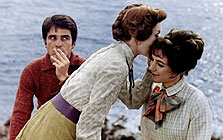|
|
|
|
Two English Girls
|
 |
Like
many cinephiles, my feelings for the films of François Truffaut have been
fickle. Jules et Jim (1961) is an overrated item that is great to see when you are 15 and
first discovering cinema, but doesn’t hold up to repeated scrutiny (all those
endless frolics through the greenery…). And so many of his works (including the
later instalments of the Antoine Doinel cycle) seem like slight confections,
hardly more thrilling than a routine comedy-romance-thriller by Stanley Donen.
In
the ‘90s, commentary on Truffaut was routed, via the publication of his
correspondence, a biography, and the documentary Stolen Portraits (1992), into speculation on his personality and
motives (was he deep or callow? tender or calculating?): the paranoid side of
auteurist fixation. And this carnival made me wonder if there was anything to really find or value in the films themselves other
than clues to his secret autobiography.
Two English Girls goes deeper into this
choreography of psychosomatic hysteria than any other Truffaut film – he called
it “not a film about physical love, but a physical film about love”. (1) I
avoided watching it for years because, as an adaptation of the only other novel
by Henri-Pierre Roché, it was designed as a companion piece to Jules et Jim.
But it turns out to be among the severest and most minimal of the director’s
works, almost an anti-Jules et Jim in
its withdrawal of empathy from the characters, its clipped style, and its
refusal to charm (especially in the direction of Jean-Pierre Léaud – whose
posturing, alienated mannerisms are matched at every turn by the equally
stylised and nutty gestures of Stacey Tendeter).
Claude
(Léaud), Muriel (Tendeter) and Anne (Kika Markham) belong to one of the many
‘lost generations’ that mark modernity from the birth of industrialisation to
Gen-X. Like Cukor’s Sylvia Scarlett (1935), the film (co-scripted by Jean Gruault) traces, without judgement, a
giddy confusion; no twin-combination of these characters can ever make a
successful connection, since no one can sort out libidinal impulses from
sentimental yearnings, sophisticated arrangements from foolish mistakes.
Truffaut’s mise en scène manages to
be at once calm and logical, as well as obsessive and sensual: for De Baecque
and Toubiana, it explores “the feverishness that binds human beings in
passionate intimacy; the impulses that overpower the body and from which no one
can escape”. (2)
The
plot is a painful litany of misread motives, stop-go signals, ugly partings and
awkward reunions. Truffaut, always alive to undertones of perversity, enters
into both the delight and the frustration of a situation in which potential
lovers are also ‘brothers and sisters’ to each other and the world, and where
the still smouldering sexuality of the ‘old folks’ guarding the social order
sometimes inadvertently breaks through the etiquette. The film builds through
teasing skin games (a kiss through a chair in a parlour game, one body rocked
back and forth between two others) to (in the context) ‘raw’ scenes of sexual
congress that are disturbing in their intensity, and perilous in their
consequences.
“Beginning
here, things must go very fast”: these words, scribbled by Truffaut in the
margin of Roché’s book and visible during the credits, betray the obsession
peculiar to him with narrative speed, compression of information and tight,
telescopic transitions. The iterative tense (‘every day they walked…’) is the
hardest thing to signify in cinema, but Two
English Girls is full of iterative scenes, because it is a profoundly
literary film, with (in de Baecque’s words) “a novelistic flesh… literally
filmed”. (3) The film goes fastest when it hits the pure plateau of letters
written, sent, received, read, exchanged, discussed between the trio; in
exploring varying ways to depict this great flow of words, Truffaut quietly
radicalises the parameter of voice-over narration (before Terrence Malick’s Badlands, 1973, but well after Marcel
Hanoun’s sadly little known Une Simple
histoire [1959]). And this substitute ‘flesh’ ends up becoming another
thick veil, another delicious but maddening wall of repression cocooning all the
characters within their morbid symptoms.
Posters
of and grabs from Jules et Jim are plastered over Vanilla Sky (2001) and Amélie (2001), but my bet is that Two English Girls has had the deepest
influence where it really counts. Jean Eustache described it as the one and
only work to provide a “deep justification” for the Nouvelle Vague, and his
subsequent Mes petites amoureuses (1975) likewise plunges into the subtly kinky vibrations intertwining children,
adolescents and adults. Malick may have got the idea of using Nestor Almendros
as his cinematographer on Days of Heaven (1978) after seeing it; the films share similar, Murnau-like tableaux of
vehicles and bodies meeting and parting in the landscape. Chantal Akerman borrows for Night and Day (1991) the
spooky yet thrilling moments when a certain gesture of love is performed
exactly the same way, and seen from exactly the same point, as with another
lover. The insistent ‘text’ of written words and their bold staging as
into-camera speech reappears in Scorsese’s The Age of Innocence (1993). Ian MacKillop’s invaluable book Free Spirits: Henri-Pierre Roché, François
Truffaut and the Two English Girls (Bloomsbury, 2000) suggestively connects
the film to David Cronenberg’s Crash (1996), James Toback’s Two Girls and a Guy (1998) and
Stanley Kubrick’s Eyes Wide Shut (1999) – which happen to be three of my
favourite films about the vexed, erotic manners of today.
And
how not to see today, in the ultimate spectacle of Claude/Léaud confronting his
prematurely aged self in a reflective surface, the prefiguration of the same
actor seen as he is today and also as he once was for Truffaut in
MORE Truffaut: Day for Night, Love on the Run, Mississippi Mermaid book review:: Totally Truffaut: 23 Films for Understanding the Man and the Filmmaker © Adrian Martin February 2002 1.
Quoted in Antoine de Baecque and Serge Toubiana, Truffaut: A Biography (New York: Alfred A.
Knopf, 1999), p. 284. back |
![]()